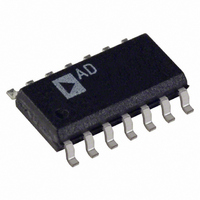AD8013AR-14 Analog Devices Inc, AD8013AR-14 Datasheet - Page 10

AD8013AR-14
Manufacturer Part Number
AD8013AR-14
Description
IC OPAMP SINGLE SUPPLY 14-SOIC
Manufacturer
Analog Devices Inc
Datasheet
1.AD8013ARZ-14.pdf
(12 pages)
Specifications of AD8013AR-14
Slew Rate
1000 V/µs
Mounting Type
Surface Mount
Rohs Status
RoHS non-compliant
Applications
Current Feedback
Number Of Circuits
3
-3db Bandwidth
140MHz
Current - Supply
3.5mA
Current - Output / Channel
30mA
Voltage - Supply, Single/dual (±)
4.2 V ~ 13 V, ±2.1 V ~ 6.5 V
Package / Case
14-SOIC (0.154", 3.90mm Width)
No. Of Amplifiers
3
Bandwidth
280MHz
Amplifier Case Style
SOIC
No. Of Pins
14
Settling Time
18ns
Operating Temperature Max
85°C
Lead Free Status / RoHS Status
Contains lead / RoHS non-compliant
Available stocks
Company
Part Number
Manufacturer
Quantity
Price
Company:
Part Number:
AD8013AR-14
Manufacturer:
AD
Quantity:
46
Company:
Part Number:
AD8013AR-14
Manufacturer:
ADI
Quantity:
297
Part Number:
AD8013AR-14
Manufacturer:
ADI/亚德诺
Quantity:
20 000
Company:
Part Number:
AD8013AR-14-REEL
Manufacturer:
LT
Quantity:
124
Part Number:
AD8013AR-14-REEL
Manufacturer:
ADI/亚德诺
Quantity:
20 000
AD8013
C
20
50
100
200
300
Overload Recovery
The three important overload conditions are: input common-
mode voltage overdrive, output voltage overdrive, and input
current overdrive. When configured for a low closed-loop gain,
the amplifier will quickly recover from an input common-
mode voltage overdrive; typically in under 25 ns. When con-
figured for a higher gain, and overloaded at the output, the
recovery time will also be short. For example, in a gain of +10,
with 15% overdrive, the recovery time of the AD8013 is about
20 ns (see Figure 30). For higher overdrive, the response is
somewhat slower. For 6 dB overdrive, (in a gain of +10), the
recovery time is about 65 ns.
Figure 30. 15% Overload Recovery, G = +10 (R
R
Figure 29. Pulse Response Driving a Large Load Capacitor.
C
500
Table II. Recommended Feedback and Series Resistors vs.
Capacitive Load and Gain
L
L
L
= 1 k , V
– pF
= 300 pF, G = +2, R
Figure 28. Circuit for Driving a Capacitive Load
V
IN
V
V
S
OUT
OUT
V
V
= 5 V)
R
IN
IN
G
100
100
0%
0%
90
10
90
10
2k
2k
3k
4k
6k
7k
R
R
T
F
– Ohms
R
1V
5V
500mV
500mV
F
AD8013
F
= 6k, R
+V
–V
11
4
S
S
0.1µF
0.1µF
S
= 15
1.0µF
1.0µF
G = 2
25
25
20
15
15
15
50ns
50ns
R
15
S
R
S
– Ohms
F
C
L
= 300 ,
V
G
15
15
15
15
15
15
O
3
–10–
As noted in the warning under “Maximum Power Dissipation,”
a high level of input overdrive in a high noninverting gain circuit
can result in a large current flow in the input stage. Though this
current is internally limited to about 30 mA, its effect on the
total power dissipation may be significant.
High Performance Video Line Driver
At a gain of +2, the AD8013 makes an excellent driver for a
back terminated 75
differential gain and phase errors and wide 0.1 dB bandwidth
can be realized. The low gain and group delay matching errors
ensure excellent performance in RGB systems. Figures 34 and
35 show the worst case matching.
Figure 31. A Video Line Driver Operating at a Gain of +2
(R
F
Figure 32. Closed-Loop Gain & Phase vs. Frequency
for the Line Driver
Figure 33. Fine-Scale Gain Flatness vs. Frequency,
G = +2, R
= R
V
IN
G
+1
–1
–2
–3
–4
–5
–6
0
from Table I)
1M
+0.2
+0.1
–0.1
–0.2
–0.3
–0.4
–0.5
CABLE
0
1M
75
L
PHASE
GAIN
= 150
R
G
75
video line (Figures 31, 32, and 33). Low
R
10M
F
AD8013
FREQUENCY – Hz
10M
+V
–V
11
4
FREQUENCY – Hz
V
S
S
S
= +5V
0.1µF
0.1µF
V
V
S
S
= +5V
= +5V
100M
100M
75
V
S
V
= 5V
CABLE
S
G = +2
R
75
= 5V
L
V
= 150
S
G = +2
R
L
= 5V
= 150
75
1G
0
–90
–180
–270
1G
REV. A
V
OUT













